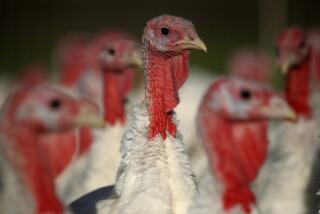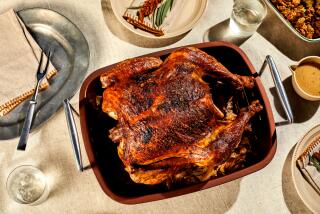Thanksgiving video: Brining the turkey

Brining and roasting a turkey is easier than you think. LA Times food editor Russ Parsons uses salt, lemon and rosemary to perfect this holiday meal.
- Share via
Over the last couple of years, much has been written about brining the Thanksgiving turkey. I know, because I’ve written a lot of it (the kind folks at Food 52 even list it as a “genius recipe”). I’ve refined the technique over the years and even used it for cooking a whole turkey on the grill.
But there are still some questions that regularly get asked.
First, it’s important to understand the difference between traditional brining and what I call dry-brining (linguists get livid about that phrase -- insisting that brine by definition includes water; they may be right, but I have yet to hear a better description).
Recipes: 41 terrific turkey recipes
In traditional brining, you soak the turkey (or ham, or chicken, or whatever you’re cooking) in water in which you’ve dissolved a certain amount of salt. I favor a 5% brine, which means about 2/3 cup of salt for a gallon of water. You can add other flavorings as well. One common addition is sugar, which I don’t use -- I find it perfectly replicates the flavor of turkey luncheon meat.
The main aim of brining, though, is not just flavoring, but also keeping the turkey moist -- not so much by the water that’s added, but by the chemical reaction the salt creates in the protein of the meat. If you’ve tried it, you know that a brined turkey is far moister than one that has not been brined, even if it’s been overcooked a little.
After years of traditionally brining my turkey -- suspending the bird in my biggest stock pot or a painter’s pail filled with water and salt, juggling it between sink and refrigerator -- I switched to dry-brining, inspired by Zuni Cafe’s Judy Rodgers and her legendary roast chicken.
In dry-brining, you sprinkle the bird with salt (about 1 tablespoon coarse kosher salt for every 5 pounds of turkey), put it in a tightly sealed plastic bag, and let it sit for several days.
It’s a lot easier than traditional brining, and I think the turkey tastes better too. The problem with traditional brining is that the bird does end up absorbing some water, and the meat after cooking has a somewhat spongy texture.
With dry-brining, there is no extra moisture absorbed (though while the turkey is under brine, you will notice that the salt pulls some moisture from the bird, most of which gets reabsorbed). The meat, though perfectly moist, has a firmer, more muscular texture, which I prefer.
Dry-brining is not quite as flexible as traditional brining when it comes to adding additional flavors, but it can be done. The most effective are dried spices and herbs and citrus zests. Simply grind the flavorings with the salt (figure 1 1/2 to 2 tablespoons per 1/4 cup of salt) and apply.
Roast as you normally would. If you’re going to stuff the turkey, underseason a little bit to offset the additional salt from the drippings (the flavor is all through the bird, not just on the outside as it normally would be). For the same reason, make the gravy separately and add pan-drippings to taste.
ALSO:
VIDEO: Making the perfect pumpkin pie
RECIPES: More than 600 holiday favorites from the Test Kitchen
More to Read
Eat your way across L.A.
Get our weekly Tasting Notes newsletter for reviews, news and more.
You may occasionally receive promotional content from the Los Angeles Times.











